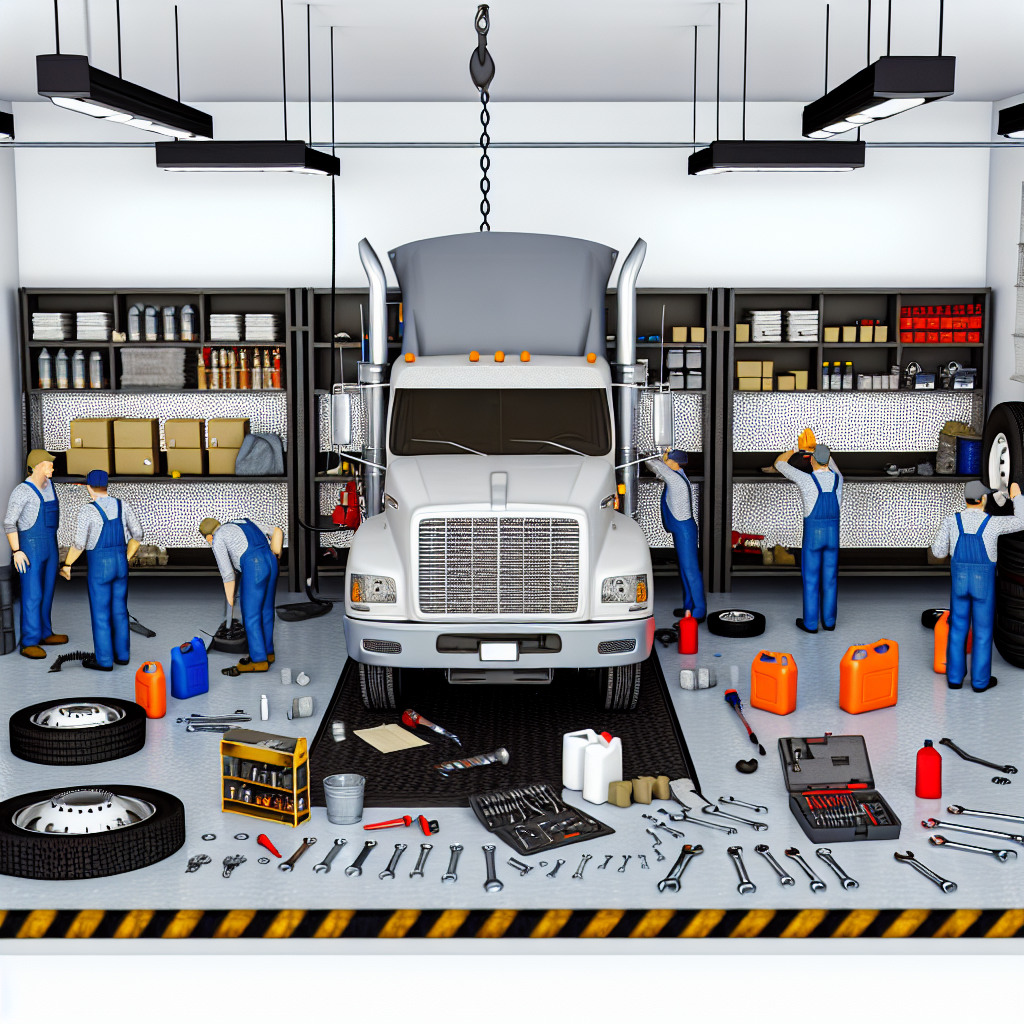Amid a tumultuous freight market characterized by fluctuating demands and rising costs, the significance of trailer and fleet maintenance has never been clearer. Recent statistics reveal a stark decline in trailer purchases, with July orders plunging by 39 percent and year-to-date figures still trailing behind the ten-year average despite a slight rebound. This retreat in trailer orders, driven by tariff pressures and an uncertain economic outlook, places increased emphasis on the need for diligent maintenance programs.
Fleet managers must navigate these challenges while re-evaluating their inventory strategies and financing options. As prices for new trailers rise by 16 to 28 percent, maintaining existing fleets becomes a critical component of reducing total cost of ownership. By prioritizing effective trailer maintenance, fleets can ensure operational efficiency, safety, and longevity of their investments—even in a weak freight market.
In today’s environment, where every dollar counts, understanding and addressing the nuances of trailer purchases and demand is essential for sustaining reliable logistics operations.


To illustrate the impact of timely fleet management, Charles Dutil stated,
“A fleet with 50 trucks will usually replace 10, 12, or 15 trailers per year.”
This quote highlights the importance of proactive reordering to maintain operational efficiency and minimize downtime. By planning to replace an adequate number of trailers yearly, fleet managers can ensure that their operations remain performant and safe.
Regular replacements are essential not just for meeting operational demands but also for the overall management of fleet resources. As fleets age, the costs associated with non-functional or underperforming trailers can escalate. Therefore, fleet managers should not only anticipate these replacements but also combine this practice with effective maintenance strategies and the adoption of advanced trailer technologies to enhance overall productivity and longevity.
Additionally, by understanding trailer utilization, fleets can maximize their investments and streamline maintenance practices. Investing in quality repairs and adopting innovative solutions can ensure fleet efficiency and mitigate costly downtime. The capacity for a fleet to adjust its trailer count dynamically according to operational needs further emphasizes the significance of Dutil’s insight on trailer replacements in maintaining a competitive edge in the logistics industry.
Thus, timely trailer replacements emerge as a critical component in driving efficiency and sustaining reliable transportation operations, aligning with a broader strategy to optimize fleet management practices.
Consequences of Neglecting Trailer Maintenance
Neglecting maintenance in trailer fleets can lead to severe financial and operational setbacks. For instance, unplanned truck downtimes can cost fleets an average of $760 per vehicle every day. This adds up to over $74 billion in annual losses for the trucking industry due to maintenance-related breakdowns.
TransWest Logistics, which has a fleet of 175 trucks, experienced 47 major breakdowns in just six months due to deferred maintenance. This negligence resulted in a staggering total loss of $2.3 million and a 23% decline in fleet availability. Such examples highlight that inadequate maintenance not only affects financial performance but also operational efficiency.
Moreover, extending service intervals can lead to catastrophic failures. A Texas infrastructure contractor decided to save $45,000 annually by extending their hydraulic service intervals from 250 to 400 hours. Unfortunately, this backfired. Fifteen machines required complete hydraulic system rebuilds, costing about $1.4 million in emergency repairs within eight months. This illustrates that routine maintenance is critical; short-term savings can quickly be eclipsed by long-term costs associated with neglect.
The effects of neglect go beyond heavy financial burdens. Equipment failures can cause significant service interruptions and operational delays. For many logistics providers, time equals money. Delays in deliveries can damage client relationships and affect future business opportunities. A good maintenance program often mitigates these risks, ensuring that trailers remain in optimal working condition and that fleets maintain high utilization rates.
Ultimately, prioritizing regular maintenance can lead to considerable cost savings over time. Implementing systematic maintenance checks and rigorous protocols can help fleet operators prevent emergencies. This not only helps ensure that trailers are secure and ready for operation but also maximizes the lifespan of assets. A well-maintained fleet creates a reliable and efficient delivery service, which is crucial in today’s competitive freight market.
| Category | Regular Maintenance Costs | Purchasing New Trailers Costs | Long-Term Savings | Downtime Impact | Total Cost of Ownership |
|---|---|---|---|---|---|
| Average Yearly Cost | $5,000 | $40,000 + financing | Maintenance can save 30% over time | Minimal downtime with planned maintenance | Maintenance often cheaper in the long run |
| Major Repairs (every 3 years) | $15,000 | N/A | Reduces needs for repairs | Downtime during repairs | Costs accumulate without effective maintenance |
| Depreciation Per Year | N/A | $4,000 | Enhance value retention | N/A | New trailers depreciate faster |
| Operational Efficiency | Increases with upkeep | Initial drop in efficiency | Sustained higher efficiency | Immediate drop – training new equipment | Long recovery if not maintained |
| Trade-in or Resale Value | Higher due to conditioning | Lower resale value due to age | Regular maintenance boosts value | N/A | Maintenance adds equity |
| Maintenance Program Adoption | $3,000 | N/A | Can save 20% over time | Reduced unexpected breakdowns | Enhances overall cost-effectiveness |
User Adoption Data on Maintenance Programs
User adoption data regarding trailer maintenance programs emphasizes the critical role that proactive maintenance plays in extending the lifespan of trailers and enhancing operational efficiency. While specific adoption statistics may be limited, a collection of analyses and expert opinions sheds light on the positive impact of regular maintenance:
- Preventive Maintenance Impact: According to analysis from JB Trailer Service, routine maintenance serves as a preventative measure that identifies and resolves minor issues before they escalate into costly repairs. Regularly servicing key components such as brakes and tires ensures optimal performance and enhances safety.
- Financial Benefits: A study by JB Trailer Service notes that routine inspections can prevent premature component replacements and save substantial money over time. By rectifying issues early through systematic checks, trailer owners can avoid expensive repairs, highlighting a solid economic incentive for maintenance.
- Real-World Case Studies: Case studies indicate that families maintaining trailers through rigorous schedules have successfully extended their lifespan significantly. One example mentioned involves a family who kept their travel trailer in excellent condition for over 15 years with consistent maintenance.
- Strategic Recommendations: Strategies outlined by industry experts further emphasize the importance of tailored preventive maintenance programs, helping trailer owners maximize both longevity and safety.
In conclusion, regular maintenance not only prolongs the lifespan of trailers but also aligns with financial prudence, making it a crucial focus for trailer owners.
Conclusion
In the current landscape of a weak freight market characterized by declining trailer purchases, the significance of strategic maintenance cannot be overstated. Proactive maintenance is not merely an operational necessity; it is a critical investment that extends the lifespan of fleet trailers and ultimately reduces the total cost of ownership.
As equipment becomes an increasingly vital asset, implementing rigorous maintenance protocols allows fleet managers to counteract adverse economic conditions. By focusing on preventive measures, such as regular inspections and timely repairs, fleets can dodge the pitfalls of unexpected breakdowns that lead to costly downtimes and operational disruptions.
Moreover, by ensuring that equipment remains in optimal condition, fleets can improve their operational efficiency, enhancing overall performance and service reliability. This approach not only supports existing logistics operations but also positions fleets favorably for future growth. Therefore, making maintenance a foundational element of fleet management strategies empowers businesses to weather economic uncertainties while maximizing the longevity of their investments.
In the current climate of uncertainty and declining demand, it is essential to understand the mindset of fleet managers. John Foss aptly summarized this cautious atmosphere by stating,
“Certainly, I think there’s no confidence [among customers] to go out and place great big orders for new equipment.”
This lack of confidence is mirrored in the significant drop in trailer orders, which have fallen drastically due to economic pressures and weak freight performance.
Fleet managers are now more inclined to maintain their existing equipment rather than invest in new acquisitions. As a result, organizations must prioritize the longevity and reliability of their current assets, ensuring they remain operationally efficient in an unpredictable market. This strategic focus on maintenance reflects broader market trends that underscore the necessity for careful resource management and planning.
The Role of Tariffs in Trailer Pricing
Recent tariffs on imported materials have significantly impacted trailer pricing, with estimates of price increases ranging from 16% to 28%. This situation presents considerable challenges for fleet purchasing decisions, particularly in the context of a weak freight market.
Impact of Tariffs on Trailer Pricing
The introduction of tariffs has raised costs in several ways:
- Material Costs: Tariffs on steel and aluminum have led to higher manufacturing expenses. Dan Moyer, a senior analyst at FTR, suggests that the overall impact is expected to be between 16% and 18% on dry van and reefer trailers, and between 17% and 30% on other heavy-duty trailers.
- Component Costs: The price of essential components has also surged. For instance, trailer tires imported from Mexico, which earlier sold for approximately $400 per set, may now cost over $500 due to tariffs of 25%. Additional surcharges of 20% to 25% on steel tubing and frames used in chassis construction could add between $300 to $700 to the base manufacturing costs of trailers.
Broader Implications for Fleet Purchasing Decisions
In an already weak freight market, these increases have substantial repercussions on fleet purchasing strategies:
- Deferred Purchases: With prices rising, many fleet buyers are delaying their purchases, uncertain about committing to higher costs. Dealerships are also cautious about stocking trailers that are subject to tariffs, creating a ripple effect in inventory management.
- Maintenance Cost Considerations: The tariffs contribute to an overall increase in the cost of ownership, consequently affecting fleet managers’ decisions regarding maintenance versus purchase. The fear of escalating costs encourages fleets to focus on maintaining their existing trailers rather than acquiring new ones.
- Market Confidence: The freight market remains fraught with uncertainty, and this lack of confidence tempers enthusiasm for large orders of new equipment. As highlighted by industry experts, the economic climate forces fleet managers to prioritize efficient resource management and be prudent in their purchasing decisions.
Conclusion
The role of tariffs in escalating trailer pricing cannot be understated, as they create significant pressures on fleet purchasing decisions. In this weak freight environment, fleets must navigate these cost increases carefully while focusing on the maintenance of their existing assets to minimize downtime and disruption in service.
Key Takeaways on Fleet Replacement
- Proactive Replacement: Fleet managers should plan to replace 10 to 15 trailers annually to maintain efficiency and safety.
- Cost Management: Regular replacements help manage costs associated with aging trailers and prevent high repair expenses.
- Maximizing Utilization: Understanding trailer utilization aids in making informed decisions on the timing and quantity of replacements.
- Integration with Maintenance: Pairing replacements with a solid maintenance strategy can enhance fleet productivity and longevity.
- Adaptability: Fleets should have the flexibility to adjust trailer counts based on changing operational demands, thus maintaining a competitive edge.
Incorporating trailer maintenance best practices is essential for ensuring the longevity of fleet assets. By prioritizing regular inspections, proactive maintenance, and advanced technologies like telematics, fleet operators can significantly extend the lifespan of their trailers while optimizing costs. Additionally, leveraging fleet management technology enables predictive maintenance and efficient route planning, reinforcing the relationship between maintenance and operational efficiency. Emphasizing asset longevity strategies like preventive maintenance and optimized asset utilization will lead to reduced total cost of ownership and enhanced service reliability in the competitive logistics landscape.


